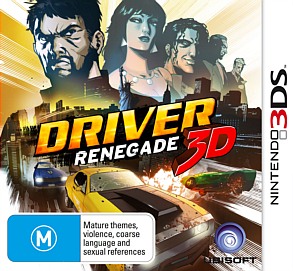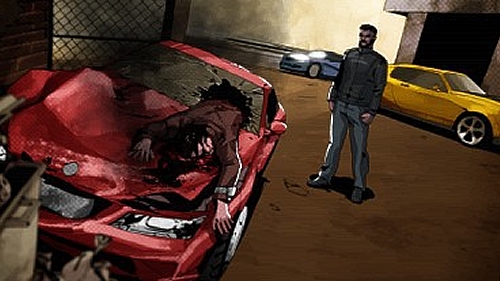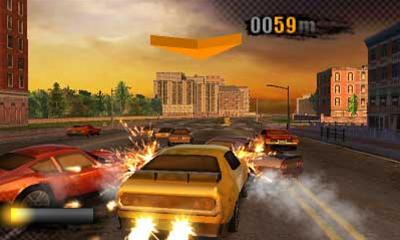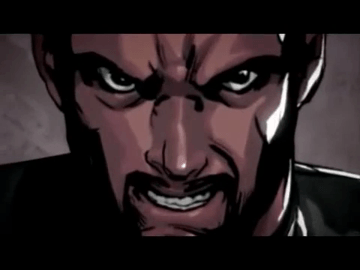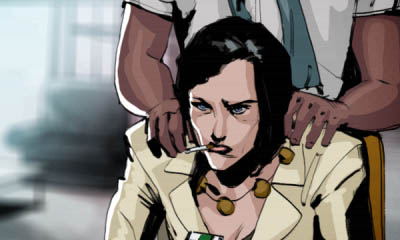Driver Renegade 3D
Developer: Ubisoft
Publisher: Ubisoft
Platform: Nintendo 3DS (reviewed)
Release Date: August 30, 2011
Price: $39.99 (Available HERE)
PREMISE
When taking a close look a crime-styled sandbox games, every title that ISN’T Grand Theft Auto has one heck of a reputation and standard to live up to. The surge in popularity of Sandbox games stands as a testament to both their design and appeal. However, the Driver game series has also devoted itself to the crime-style sandbox genre almost as long as mainstream GTA titles. As the name implies, the series has long been known for focusing on the vehicle and driving aspects of city-sandbox gameplay.
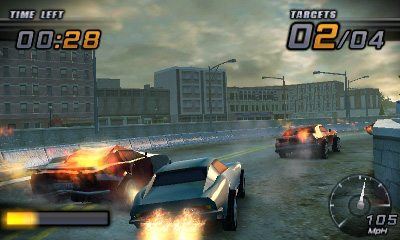
Driver Renegade 3D is the latest addition to the series, at least in terms of the handheld market. The game was released on the 3DS in conjunction with the releases of Driver: San Francisco on the Xbox 360, Playstation 3 and Wii, so that the love may be spread around for the handheld market just as much as it was on the console systems. It should be noted that, although both titles feature the same lead character and a few similar gameplay elements, the two are completely different games. And typically, whenever a multi-platform release is concerned, most gamers tend to think that the Nintendo based, or handheld releases don’t live up to the standard of their ‘hardcore’ console counterparts. So does Driver Renegade 3D stack up against the rest?
STORY / CAMPAIGN
Driver Renegade takes place contextually as a prequel to many of the other driver games. The story takes place in New York in the time frame between the events of Driver 1 and 2. Following the events of the first Driver game, the protagonist of the story: John Tanner, has quit his former gig as an NYPD officer due to his resentment of formal procedure and seeing justice rarely done in a New York city where criminals rule the streets. During a job interview for a private security firm, Tanner witnesses a small group of criminals beat a nearby group of people senseless and kidnap an apparent VIP. For whatever the reason, Tanner quickly gives chase in his car. After catching up with the kidnapper and forcing him out of his car, Tanner makes a quick rescue of the VIP, who reveals himself to be a government senator who shares a very similar view of the justice system. After seeing Tanner in action, the Senator offers Tanner a job to take down the city’s crime lords with unlimited authority and no restrictions, such as those of the NYPD. In other words the senator makes him a Renegade protected by the law. The storyline of the game involves 20 driving missions where the players unravel the web of corruption that has been spun over the city by investigating and subsequently eliminating the major sources of crime in the city.
As far as the story element of the game is concerned, it barely holds itself together in terms of player appeal. It’s a story that has been told a thousand times before. Just from playing through the first 5 missions, everything feels unoriginal and the cinematics are where everything advances, rather than in the game itself. Ultimately, it’s simply a story about a protagonist with a deep seeded loathing of authority, but through his own mistaken actions he learns that his form of justice is wrong, that he must learn patience, endure life’s hardships, and bring balance to the Force blah blah blah. We’ve heard it a million times before. The characters are largely forgettable and uninspiring, and the ending plot twist, (which seems to be a mandatory feature of sandbox games these days), was extremely weak. Not weak in that it shocks the audience, but because ANYONE could see it coming. The major villains of the game is made all too obvious, simply by way of visual design and voice. When it comes down to a true measure of quality, player’s want to feel like they’re part of the story. And this game really did not deliver on that.
It felt like the whole time the story was being just lectured to us through cinematics, and that gameplay only existed solely for the purpose of breaking it up. It was also horrendously short. I know many games have a problem with limited longevity and play time, but this game is easily completable within the first 2 hours of play. Additionally, the story of the game did not endear Tanner to me as an important or relatable character by virtue of his constant “I want to rebel against everything” attitude. This did not work in the game’s favour, because Tanner acts as the players window into the universe. If the protagonist is poorly developed, then chances are players will see the rest of the game through such a filter.
GAMEPLAY
The primary gameplay elements of Driver Renegade are broken up into a series of missions that each involve the same gameplay controls, but feature differing objectives for completion. Many of the missions will typically involve some form of carrying out wanton destruction either on the environment, or on enemy vehicles. Some of the game modes include Rampage, where the player must defeat a prerequisite number of enemy vehicles, Chase, where the player must tail a target vehicle to a specific location while trying to stay alive, and Escape, which is essentially a reverse of the Chase type mission, where the player must avoid enemy vehicles and make it to an escape point.
It must be said immediately, that regardless of which mission type you’re playing, the whole experience feels very much the same. Regardless of your mission type, players will find themselves making the same actions over and over again. Smash things to gain RAGE energy, use RAGE to smash enemy cars. Enemy cars respawn. Smash more stuff, etc. The whole thing feels highly repetitive, and severely lacks variety when it comes to what you will see happening in actually gameplay. In fact, I can only think of 1 mission where Tanner has to avoid the police WITHOUT destroying them, where the mission felt honestly different, and it was the only one where I felt the game was truly trying to mix things up. But no, immediately after, it returns to the repetitive pattern.
In actually playing the game, the controls are thankfully quite simple. Anyone who has played a racing or vehicle based game before in the past will find the controls familiar territory. The directional pad or stick is used to steer, and different buttons are assigned to the accelerate, brake, handbrake and nitro (rage) functions. Players are able to build up rage by causing acts of destruction on enemy vehicles, or on the environment itself. After the player has either smashed up enough cars, or run over enough fences and streetlights, the player can enact the Rage boost, which acts a nitro function, providing a more rapid rate of acceleration, fast top speed, and most importantly, greater damage potential. To this day, I still find other cars in vehicle based games make excellent substitutes for brakes when in high speed pursuits.
Damaging other cars is a relatively simple affair, achieved in one of 2 ways: firstly, using nitrous (rage) to ram enemies head on, or by using the L and R buttons to jolt left and right, thus bumping enemy vehicles into obstacles, each other, or even oncoming traffic. In theory, this is actually a solid premise for vehicle based combat, especially in a game that has totally omitted guns from the formula. However, the physics and damage taking aspects of the game are strangely unbalanced. A player could ram an enemy vehicle head on, but it will fail to take damage unless the player had the rage bar activated. Or a player could ram a car into a building that would undoubtedly destroy it, only to see it bump off with a minimal scratch. Attacking enemy cars is still fun, but it really felt like it was always coming down to a matter of luck when it came to destroying them. Additionally, after destroying an enemy, most will quickly respawn right behind you, adding a sense of futility to the combat.
Besides story mode, the game also features a Career mode gametype, which essentially provides the player with more of the same types of missions they would have experienced in the Story mode. With one exception. ACTUAL RACING. That’s right, the vehicle based game finally pulled out some racing. Was the Career mode any better? No. In fact, as repetitive and homogenous as the gameplay featured in story mode was, the career mode found a way to make it seem even monotonous by providing 12 almost identical missions of each mission type. Each time, the only thing that changes is the course of area in which the mission takes place. The race missions are far too easy, regardless of whether or not you’re playing on “easy” or “hard” mode. It honestly felt lacking in challenge, and additionally, in potential rewards.
The rewards system of the game is also slightly flawed. While it is cool to be able to unlock a large variety of vehicles for use in career mode (especially the military vehicles), the game’s lack of multiplayer functions limit the appeal of being able to unlock additional, better or upgraded vehicles. The lack of a competitive feature beyond leaderboards severely limits the longevity appeal of the game, racing and general vehicle use is a type of game that tends to appeal towards multiplayer markets. The insertion of such a mode would have provided greater intrinsic value for the players to show off their car collection and provide an incentive to finish the entire career mode.
VISUAL / AUDIO
The visual aspect of the game did clearly make an attempt to integrate the 3D element of the consoles 3D capabilities. However, the graphical quality is very poor. The modelling of the environments and the vehicles themselves are highly simplistic, and hold a standard of graphics that look to have arrived 5 years too late. The game is clearly attempting to appeal to the wrong aspect of the 3DS’s powerful graphics capabilities. Rather than utilising the graphics focus on the 3D, it should have been better focused on the base visual design. It feels like the whole gameplay visual style was done as a rush job. Additionally, during gameplay, for a game that claims to encompass New York city, one of the biggest, most lively cities in the world, there is a severe lack of people. The whole in-game experience feels empty. The entire city feels like a ghost town with only a small handful of NPC vehicles driving slowly and existing only as a physical impediment to the player.
To the game’s credit, I actually did enjoy the comic book style of graphics that the cinematics of the story took, but there’s no doubt that many of the visuals shown were extensively reused. The profile shot of Tanner himself is re-used numerous times, either the whole face or just his eyes. Get used to seeing it, because you’ll have to see it ALOT throughout the campaign.
The voice acting of the game is laughable and forgetful. Not only that, it’s also annoying. All of the recurring characters’ voices are scripted to sound as clichéd as possible. I don’t know whether or not that was intentional, but the constant repetition of a certain snake-like voice might as well scream “BY THE WAY, I AM THE VILLIAN.” But Tanner is the worst offender by far. Every snarky line he has in both the cinematics and the gameplay make him sound like an egotistical wannabe badass. Get used to hearing things like “NOW YOU MADE ME MAD!”, “Aw, I was just starting to have fun”, and “The more the merrier!”. Over and over again. At least 3 times a mission. Each. While this is the fault of the scripting and not the voice actor himself, Tanner’s one-liners only succeeded in making him all the more unrelatable, thereby closing the player’s window to the world further. Toning down the cockiness and instilling a sense of limitation to a man feeling limited in the world may have better supplemented his character, and thus, the eyes in which the players see the world through.
The one area I felt the game did do well in terms of audio was music selection. The combination of Rock and Funk genres to the game helped instil a subconscious sense of speed and danger. Regardless of the visual, if the soundtrack is appropriate, the audience will respond in an appropriate fashion. As a result, many players will feel that many missions will build in intensity as the soundtracks progress and build up to a suspenseful riff. The music selection also fits very well with the genre, especially in relation to the vehicle centralised focus of the game.
CONCLUSIONS
In my opinion, the game really does not live up to the expectations that one would expect from a sandbox genre game. It features no free-roaming segments, the story unoriginal and the gameplay repetitive. The game clearly had quite a bit of potential to really appeal in the handheld market, but like so many other titles have done in the past, I feel that this game has been dragged down by the weight of its console counterparts. Unfortunately, as a multiplatform release, it falls directly into that hole in which the handheld version feels inferior in quality. It feels like the whole experience was made as a rush job to supplement the release of Driver San Francisco. With a little more time given to especially gameplay, this could have been a much stronger contender. For fans of the Driver series, it is at least worth a look to get the untold story of Tanner prior to the events of Driver 2, but to most, this game really will not hold a great deal of appeal.



